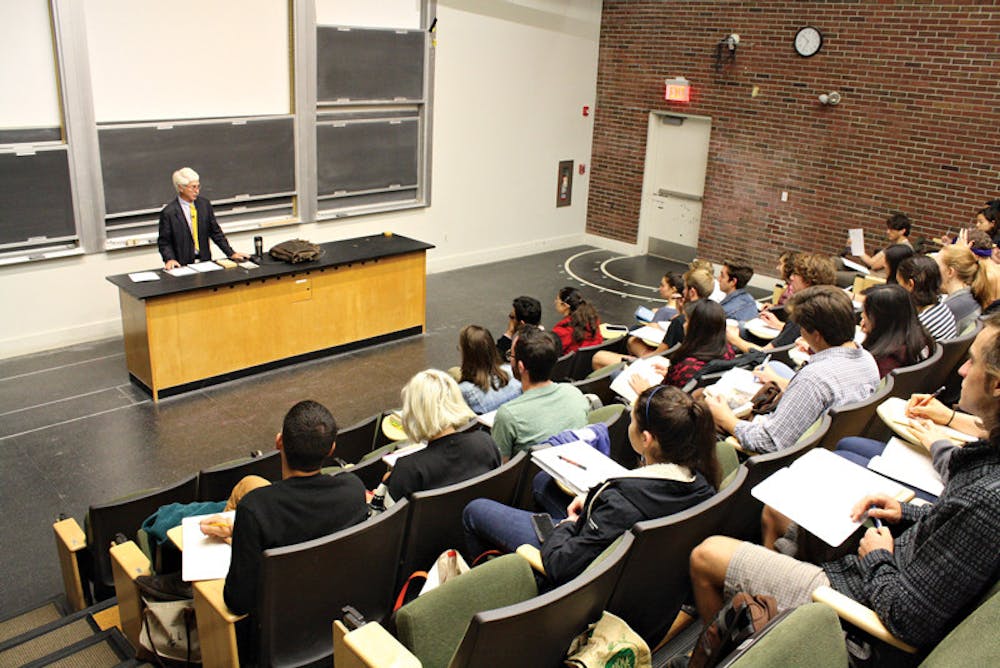Provost Vicki Colvin is leading the charge toward a digitalized educational experience at Brown, focusing on flipped classrooms and online courses as ways of realizing a major initiative in President Christina Paxson’s P’19 strategic plan. Colvin said she will reach out to faculty members in March to gauge interest in flipping classrooms.
In a flipped classroom, students watch lectures online for homework, while class time is used for the professor to more actively assist students with problem sets and applied work, Colvin said.
This particular form of digital education embodies Paxson’s call for “aggressive experimentation in new modes of education, testing new ideas, assessing their efficacy and adapting them as necessary” — a goal detailed in the educational leadership section of her strategic plan, “Building on Distinction.”
At Rice University, where Colvin taught before coming to Brown, she offered a flipped course in analytical chemistry. “A lot of my view on this is informed by my own experience,” she said.
For the course, she filmed her lectures and uploaded them for students to watch outside of class. In a departure from the large lecture halls in which science, technology, engineering and mathematics classes are often held, Colvin taught the flipped analytical chemistry course in a large, flat classroom, dividing the total number of students registered for the course into smaller sections of about 50. In these relatively small classes, the students broke off into groups to tackle problem sets together. Colvin and several teaching assistants circulated throughout the room, helping groups with specific problems.
“If you’re looking at 100- to 150-person lectures, this is a good way to get more professor-student interaction,” Colvin said, adding that she learned the names of more students in the flipped format than she did when “standing in front of a classroom.”
A target area for the use of flipped classrooms is STEM courses that typically attract underclassmen, Colvin said. When observing calculus sections in Barus and Holley, Colvin noticed “there is someone up at the board doing problems and everyone is scribbling notes — some people were even trying to take iPhone pictures of it,” she said. Flipping these kinds of courses “might be a better option,” she added.
One section of the course ECON 1110: “Intermediate Microeconomics” that used a flipped-classroom format in fall 2013 garnered positive feedback from students. In the flipped section, students watched explanatory videos by Associate Professor of Economics Pedro Dal Bo throughout the week, reviewed problems on Wednesdays and attended lectures on Mondays and Fridays.
In the fall, Colvin convened a planning group tasked with examining how the University uses digital education and proposing steps for development.
“Higher education is changing,” said Karen Sibley, dean of the School of Professional Studies and a member of the planning group. The group’s focus was to determine how to ensure the University “delivers relevant education in an evolving context,” she said.
The group produced a “set of recommendations for the University to continue to engage in piloting online content with awareness of the costs and the time demands, and to create incentives for faculty to get involved,” Sibley said, adding that it will continue to meet and form proposals.
The group also examined other realms of digital education, such as courses offered completely online to Brown students for credit, as well as massive open online courses, which are available to the general public and cannot be taken for credit.
Online courses allow students to “be anywhere and be learning,” Colvin said. “I don’t think they threaten the physical campus. I think they just add to it, and they let our students have more freedom.”
Colvin said she aims to offer 20 online courses over the next five years. Within that time frame, she also hopes to flip more than one-third of STEM courses for underclassmen with more than 150 students.
“I would really like to see that implemented,” said Katelyn Weingart ’18, who is currently enrolled in two applied mathematics lecture courses as well as a computer science lecture course. “That’s a much more effective use of meeting with a knowledgeable person,” she said.
The video-based format of delivering information in flipped classes is how the current “generation has been learning to learn,” Colvin said. “I want to make sure we stay with the times and we’re being responsive to the needs of the students.”
“We need to be experimenting,” she added. “That’s what Brown is really good at.”





